Contact us today:

(847) 934-4500
tdaro@bernardandcompany.com

Contact us today:
(847) 934-4500
tdaro@bernardandcompany.com
Hahn Automation provides “glocal” solution to ThyssenKrupp damper business for stacking and assembly of assorted product types; enables quick recipe changes

Stackers and 4-axis FlexPickers integrated by Hahn Automation for ThyssenKrupp; used in the flexible production of various shock absorber products for customers like Mercedes, Porsche and other high-performance automobile manufacturers.
ThyssenKrupp Bilstein of America is a leading supplier of premium shock absorbers, struts and suspensions to the auto, truck, racing and other markets. With its recent development of the DampTronic® Sky, which provides continuously variable damping force adjustment of the shock absorber to accommodate road and driving conditions, the company, with U.S. operations based in Hamilton, Ohio, recognized the need for greater flexibility in its production on a global scale. With a substantial assortment of products for OEM and aftermarket alike, ThyssenKrupp required a scenario for fast recipe changes, with flexible and high-accuracy production of frequent short runs to suit its product demands in the market.
Further, with global operations in its manufacturing, the company sought to partner with an automation supplier who would mesh well with the culture of ThyssenKrupp and the engineering requirements this challenge presented. The solution came their way in Hahn Automation, based in Germany, with its U.S. operations headquartered nearby to ThyssenKrupp’s damper business, in Hebron, Kentucky.

The DampTronic® Sky technology from ThyssenKrupp provides constant variable pressure, adjusted in milliseconds to accommodate road and driving conditions, utilizing two continuously variable valves to adjust the damping force in both extension and compression modes.
This combination provided what Dave Vibbard, Senior Process Engineer at ThyssenKrupp terms a “glocal” relationship, a portmanteau word made from global and local. Correspondingly, John Baines, president of Hahn Automation, says, “We also work under the philosophy that we should build it where it gets used, so we needed a partner for the controls and application engineering assistance who could work seamlessly with both our German and U.S. operations. We found that supplier in Siemens and their local solution partner, C&E Sales.” For the project, the control supplier furnished all drives, PLCs, master HMI and remote control pendants to give freedom of movement to the operators, as they work around the cell stations. Siemens and C&E Sales also provided Hahn their application engineering assistance and the TIA Portal, an engineering network from Siemens which allows all programming of motion controllers, distributed I/O, HMI and other devices through a single point of command. In addition, TIA Portal maintains a library with the operating protocols, hardware designations and performance characteristics of task-specific projects, enabling subsequent recall, system reconfiguration on-the-fly and substantial engineering time savings for the integrator and end user alike. Hahn was able to utilize the TIA Portal at every step in the configuration and commissioning of the work cells devised for ThyssenKrupp on this project. As Baines notes, “The diversity of products being produced were all nonetheless similar in nature and mechanical composition, so many of the motion control commands and assembly sequencings could be done using the library of programmed information in the TIA Portal. Siemens provided us considerable assistance on this project, though we had previous experience with this engineering network.” Baines further notes the TIA Portal resulted in significant cost and time savings for Hahn and ultimately the end user.

Siemens drives, HMI, remote operator pendants and PLC technology operate the system. Hahn utilizes the Siemens global support of its products, while sourcing many components locally, thus the term “glocal” was coined.
On this project, Hahn provided ThyssenKrupp the first of several cells, comprising six “valve stacker” modules for the pre-assembly, kitting and riveting of the shock absorber washers and piston rod assemblies, plus the gas and oil fill, welding and functional testing procedures. For each model produced, an assortment of washers with various profiles and dimensions is stacked on the piston, assembled and then the shock absorber body is filled with gas and oil, all to pre-programmed levels. The “recipe” for each model made is stored in the HMI onboard, which drives the individual module PLCs. At each station in the cell, an operator can instantly visualize the recipe in progress and enjoys the free movement around the cell, using the remote control pendant. As the model changeover is required, the master recipe exports the particular data requirements to each module, and then the ramp-up of the overall cell begins anew. Washers of various sizes and profile configurations are used for the buildup of each model produced, so the required components are brought to the assembly stations by a series of 4-axis ABB iRB 360 FlexPickers and ceiling mounted Epson G10’s, utilizing Selective Compliance Articulated (Assembly) Robot Arm (SCARA) technology. Functionally, the various commands are executed via the PLC, an S7-1500 from Siemens, which features seamless integration with the TIA Portal, as well as fully integrated onboard safety and security modules.
As Baines explains, “The setting adjustments are quite substantial for each damper product produced, so the load on the control system required strict monitoring and validation. There’s the master cell with six modules, including four valve stackers and two final assembly stations. Interestingly, half our design and assembly work was done in Germany and half was done here in Hebron, Ky., where we also did the final configuration of the control platform, runout and performance evaluations prior to delivery to ThyssenKrupp.” He noted the support provided by Siemens, both in Germany and local to his facility. Baines also cited the upgrade to the higher level Simatic S7-1500 PLC as a significant advantage for Hahn in the overall achievement of this project’s success. He particularly noted the safety and system security features, plus the fast response time and easy commissioning of this PLC platform for his team and TK personnel.
Greg Earle, VP for sales at Hahn, adds, “The Siemens TIA portal was a terrific engineering tool, as we were able to configure all the motor and drive components in a tag-based protocol for the individual slave PLCs and the master HMI. It was a very fluid connection process and, in the field, the operators enjoy the added benefit of movement, using the remote pendants provided with the system.” As each recipe is called up, he added, the changeover time is significantly reduced, compared to the previous systems in use at ThyssenKrupp. The single supplier for the new component feed systems is located in Germany, so the presence of both Hahn and Siemens there was a further advantage to TK on this project.
Vibbard of ThyssenKrupp comments, “Hahn was extremely competent and also price-competitive on this project, a very desirable combination in any business relationship. They were able to complete the build and execute the handshaking between the modules, with full verification on performance, error tracking, safety considerations, fault recovery and alarm alerts.” He noted an extra benefit on the operator screens was a dual language capability, so immediate access and troubleshooting could be accomplished by the engineering teams both in Germany and America.
In use, all the communications in the cell, whether from the robotics PLC, Siemens hardware and software systems or Hahn proprietary logic, are transmitted on a field bus to a single point of control and command, according to Vibbard, who cites this seamless protocol as a significant upside for our process engineers and maintenance personnel alike. “The assembly and testing procedures are all TCP/IP friendly, so the cell controls are easily accessible both by our team and remotely by Hahn for troubleshooting and faster resolution of any issues.”
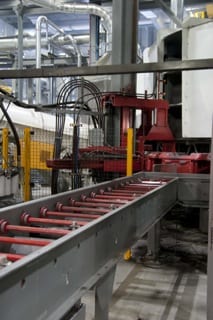
Washers of various sizes are stacked on a piston rod for assembly, with differing levels of air and oil fill to suit the specifications of the individual products at ThyssenKrupp; modular, programmable work cells provide great flexibility in production.
According to the official ThyssenKrupp description of the new shock absorber technology that partially drove the development of this project, “The new DampTronic® Sky damper (shock absorber) is a further milestone in resolving the conflict between driving comfort on the one hand – an aspect of particular interest in the premium segment – and the driving safety and agility of the car, on the other hand. In this new generation, two continuously variable valves adjust the damping force in each damper: one valve controls the rebound phase – i.e. the force that ensues when the wheel travels down – and the other controls the compression phase. Using the data it receives from the acceleration and wheel-path sensors, the control module of the suspension system can individually adapt the damping forces for each wheel within just a few milliseconds to eliminate the effects of rough road-ride conditions that may detract from the driving comfort for the passengers, while at the same time controlling the dampers in such a way that the chassis is stabilized to the best possible degree. Thanks to the use of two adjustable valves, the damper is also able to ensure that the damping force can be adjusted according to the skyhook principle even in the high-frequency spectrum of the wheel vibrations. By independently adjusting the extension and compression forces, the new ThyssenKrupp DampTronic® Sky damper constitutes the high-end system in the semi-active damper segment.”
The customer here, ThyssenKrupp, expects significant improvements in the production schedules with the Hahn Automation master cell on the floor at the facility in Hamilton, Ohio.
Baines concludes, “The relationship we established with and the solution we proposed to ThyssenKrupp would not have been possible without the assistance of the Siemens team, both here in our area and in Germany, supplying product, engineering know-how and controls expertise in both locations.”
A “glocal” success, indeed.
For more information on this story, please contact:
SIEMENS
Digital Factory
Factory Automation
5300 Triangle Parkway
Norcross, GA 30092
Phone: 770-871-3848
www.usa.siemens.com/drives
Attention: Hollie Davis, Sandra Tigert or Alisa Coffey
Or
HAHN AUTOMATION
3012 Kustom Drive
Hebron, KY 41048
Phone : 859-283-1820
www.hahnautomation.com
Attention : John Baines
Or
THYSSENKRUPP BILSTEIN OF AMERICA
8685 Bilstein Boulevard
Hamilton, OH 45015
Phone: 513-881-6394
www.bilsteinus.com
Attention: Fabian Schmahl or Dave Vibbard
About Siemens USA
Siemens Corporation is a U.S. subsidiary of Siemens AG, a global powerhouse focusing on the areas of electrification, automation and digitalization. One of the world’s largest producers of energy-efficient, resource-saving technologies, Siemens is a leading supplier of systems for power generation and transmission as well as medical diagnosis. With approximately 348,000 employees in more than 190 countries, Siemens reported worldwide revenue of $86.2 billion in fiscal 2015. Siemens in the USA reported revenue of $22.4 billion, including $5.5 billion in exports, and employs approximately 50,000 people throughout all 50 states and Puerto Rico.
Siemens announces immediate availability of two new compact quick disconnect switches used with the popular Sinamics G120D distributed drives. This new disconnect switch design mounts directly onto the input power connector of the drive and locks in place to provide a tight, reliable interface, in accordance with ISO 23570-3. Many applications exist in the decentralized distributed power environments, where control cabinets are being replaced with IP65 protected products.
Two versions of the new disconnect switches are now available. A 10-amp rated switch is offered for G120D drives up to 4 kW (5 hp) and features a daisy-chain Power-Y-junction box design to enable power wiring to additional G120D drives. A 25-amp rated version is offered for the heavier-duty 5.5 kW (7.5 hp) and 7.5 kW (10 hp) drive models. This larger unit features a standard Q4/2 pin configuration.
Through the introduction of these new disconnect switches, Siemens can now offer system integrators, OEMs and field maintenance personnel immediate availability to a drive and connector package for a number of applications, according to Robert Soré, product marketing manager, Sinamics general purpose drives at Siemens. “We’ve developed this product line in tandem with our solution partner Harting and we see it expanding our presence in the distributed, decentralized control markets, which include automotive, packaging, metals processing, food and beverage, as well as general conveyorized material handling.”
For more information about these new quick disconnect switches, please visit:
www.usa.siemens.com/sinamics-g120d
For specific product information and inquiries, call (800) 879-8079 ext. Marketing Communications or send an e-mail to: SiemensMTBUMarCom.industry@siemens.com.
Motor-integrated drive offers onboard safety features and communications
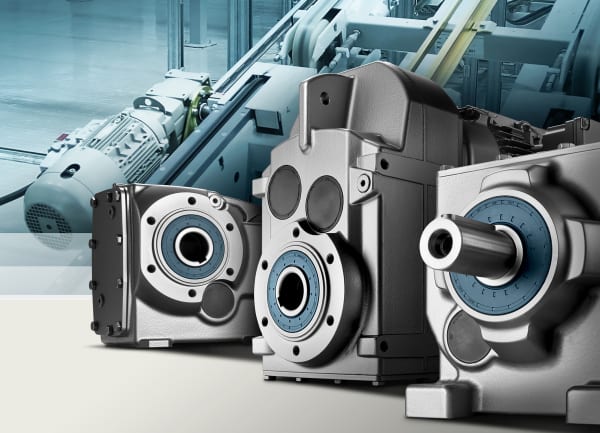 Siemens introduces the Sinamics G110M, a motor-integrated drive for Simogear gear motors, offering flexible control, integrated safety, simple installation and a space-saving design. With a high degree of protection — up to IP66 — this new gear motor drive provides the perfect solution to most material handling-related challenges, including conveyors, warehousing, logistics, baggage and cargo handling, post and parcel shipping, plus numerous industrial applications in the automotive, appliance and test stand industries.
Siemens introduces the Sinamics G110M, a motor-integrated drive for Simogear gear motors, offering flexible control, integrated safety, simple installation and a space-saving design. With a high degree of protection — up to IP66 — this new gear motor drive provides the perfect solution to most material handling-related challenges, including conveyors, warehousing, logistics, baggage and cargo handling, post and parcel shipping, plus numerous industrial applications in the automotive, appliance and test stand industries.
Simogear gear motors offer high torque density, low noise and high efficiency — and now with Sinamics G110M, it becomes easier for designers and system builders to integrate gear motors into a variety of control architectures. Plug connections for onboard I/O ensure fast installation, while optional power connectors deliver even more time savings. The system is delivered pre-configured and the drive offers simple yet comprehensive onboard diagnostic features. Options such as internal braking resistors and motor brakes — operational simultaneously — and integrated features such as “Quick Stop” and the limit switch function make this system ideal for conveyor applications.
For uses requiring safety technology, the Sinamics G110M offers integrated safety functions such as “Safe Torque Off” (STO), which can be activated via a fail-safe input or via Profisafe, without needing additional safety monitoring components.
Sinamics G110M features integral USS/Modbus RTU, Profibus and Profinet / EtherNet/IP communication profiles.
To watch a video of the Sinamics G110M for the material handling industry, please visit: https://www.youtube.com/watch?v=GgDxptBqpHg
For specific product information and inquiries, call (800) 879-8079 ext. Marketing Communications or send an e-mail to: mc.us@siemens.com
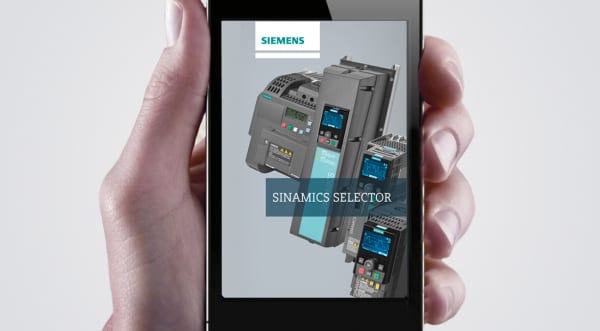 Simply practical. Simply good.
Simply practical. Simply good.
Drive selector app enjoys growing polarity
For some time, it has been apparent that mobile apps have been spreading more and more across the industrial environment and have become a popular medium among users. One special feature in this field is the variable frequency drive app for the easy selection of all necessary components from the respective corporate portfolio. The online selection is always up-to-date, available in many different language versions and saves the user time — laboriously poring over catalogs is now a thing of the past.
Due to the special requirements in some cases, selecting the right drive is not always straightforward and can often waste valuable time. After all, the fields of application and the requirements regarding operating behavior and costs are wide-ranging. Whether the drives are used to operate pumps, fans or compressors, or to drive conveyors, mixers or kneaders, it is important to find the appropriate drive for the required range of performance and voltage quickly and easily for each of these applications. And wherever possible, this must be done without the need for expert knowledge of drive technology.

The Sinamics Selector app helps you to select a suitable drive in just a few simple steps and also suggests alternative options.
Assembling components by smartphone
In order to simplify this sometimes complex process, Siemens, for example, has been offering its Sinamics Selector app free-of-charge. This is a solution that displays the entire collection of products from the portfolio of low-voltage frequency drives — Sinamics V20, G120C, G120 and G120P — on the most popular iOS and Android smartphones and can be used both online and offline. This offline capability is of particular importance in regions which do not have full cellphone coverage. Since Version 4.0, not only have brochures, product videos and application examples (Fig. 1) been available to users and electrical distributors, but also more language versions.
Everything up-to-date
Katharina Roehrlein, marketing manager for Sinamics drive systems at the Siemens Digital Factory division, explains additional innovations: “With the latest update, Version 5.0, we have adopted the second generation of the Sinamics G120 modular Frame Size D-E, as well as the Sinamics V20 Power Extension up to 30 kW, into the app. In addition, we have integrated more technical values such as resistance, peak performance and continuous power ratings into the logic of the app. And for good reason, because we want to make it as easy as possible for our customers to find the right drive in order to save valuable time.”
As a matter of principle, when assembling the appropriate components, the Sinamics Selector app offers not only a product-specific, but also an application-specific approach. In other words: either the user knows from the outset which frequency drive is required, or the app guides the user step-by-step to the right drive by asking for key parameters (Fig. 2). The information held by the Sinamics Selector app is kept up-to-date at all times by the central storage of data and continuous updates. Bob Hendrickson, applications engineer at Wesco, one of the largest distributors in the United States, regards this as an enormous advantage over conventional catalogs, especially when the app can save him a great deal of time in preparing a bid. “The Sinamics Selector app is very helpful as it lets me create a complete bill of materials for a customer offer very quickly. This option saves me a huge amount of time since I no longer have to create bills of materials by hand. The app also makes it easier for me to respond to queries arising from projects when I’m on the road and don’t have any catalogs or other documents to hand.”
Bid preparation made easy
After choosing the required type of frequency inverter, the rated output, device options and accessories can then be selected and adapted individually — if necessary, also with the support of the respective Siemens contact, whose details are also stored in the app. Once the components have been selected, the user has the option of either saving or emailing them. To make it easier for end-users to get in touch later, the headers and footers of the email can be adapted individually, for example, with personal contact information. The overview includes actual part numbers for all of the selected components. This can be used as information for the customer, but also as the basis for ordering specific components or preparing an offer at the local dealer/distributor. Kevin Young, application engineer at electrical distributor C&E Sales Inc., in the U.S., also confirms this: “I really like the Sinamics Selector app. I copy the result into my bill of materials, which enables me to immediately present a bid to my customer.” His colleague Jay Swank adds, “I use the application almost every day now.”
Over 15,000 downloads and counting…
Since the introduction of the first version, the Sinamics Selector app has been installed 17,000 times on mobile devices worldwide — and the number is still rising. Apart from Europe, China and the U.S., this trend is being led by key markets such as India, Brazil and Mexico. “It is particularly important in these countries to have a solution in the local language which also functions faultlessly offline. The email containing the results can be stored and then transmitted when sufficient network capacity is available again,” adds Ralf Weber from the Siemens Digital Factory division responsible for the app.
Think global, act local
Due to the great success of the app in all language versions offered thus far, Siemens is planning the integration of additional languages, as well as the continuous support and expansion of the product range covered. The main focus here is on Europe, particularly the eastern regions.
For more information about the Sinamics Selector app, visit:
www.usa.siemens.com/sinamics-selector-pr
Access – online and offline
Cost – Free-of-charge
Platforms – iOS, Android
Languages – English, German, French, Italian, Spanish, Portuguese, Chinese, Russian, Korean and Turkish
Quicklink to the Sinamics Selector app: http://ow.ly/WFRe5
For more information on this story, please contact:
SIEMENS INDUSTRY, INC.
DIGITAL FACTORY
MOTION CONTROL — GENERAL MOTION CONTROL
390 Kent Avenue
Elk Grove Village, IL 60007
Phone: 847-640-1595
Fax: 847-437-0784
Web: www.usa.siemens.com/motioncontrol
Email: mc.us@siemens.com
Attention: John Meyer, Manager, Marketing Communications
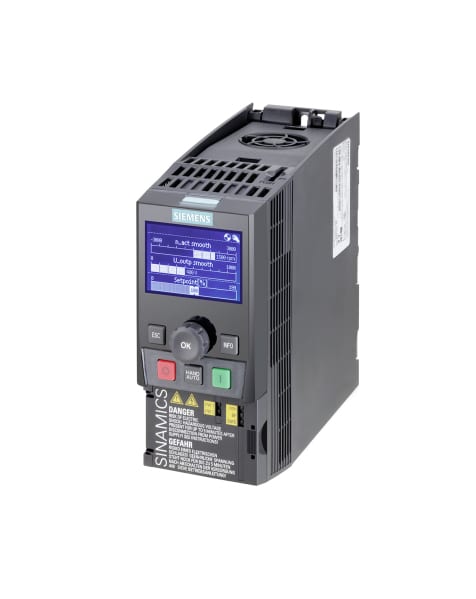
New Sinamics G120C FSAA — the “Tiny Drive” in frame size AA from Siemens Industry, Inc.
Siemens announced today immediate availability of its popular Sinamics G120C drive in AA size, which replaces the previous G120C frame size A in power ratings up to 2.2 kW
(3 hp), including communication variants for USS, PROFIBUS, PROFINET and EtherNet/IP. Offering high power density in a smaller footprint, the new “tiny drive” offers fully compatible replacement for the equivalent power ratings on the previous version.
On new control cabinet designs, the G120C FSAA has significant size advantages, up to 32% less overall volume, for the OEM or integrator, but requires no re-engineering, when migrating from the G120C FSA on current jobs. Overall dimensions on the smaller unit, designed for use with PROFIBUS and USS variants are only 173mm high x 73mm wide x 155mm deep (6.8” x 2.8” x 6.1”).
Other benefits of the new G120C FSAA include use with increased motor cable lengths,
up to 50m (165 ft) for shielded and 150m (495 ft) for unshielded, plus identical voltage ratings, current ratings, load cycles and compatibility with all standard Siemens options such as operator panels, input and output chokes, as well as external Class B EMC filters.

Sinamics G120C FSAA has smaller footprint, up to 32% less volume, but delivers comparable features to previous version of this Siemens drive.
The G120C FSAA offers UL open type, IP20 protection in the 0.55–2.2 kW (0.75–3 hp) range.
Through the introduction of this new tiny drive, Siemens can now offer machine builders another economical, space-saving and easy-to-operate standard AC drive with a wide range of functions, according to Robert Soré, product marketing manager for general purpose drives at Siemens. Typical applications for this product span a broad machine and equipment range, including smaller test stands, mixers, conveyors, fans, pumps, compressors and basic production machinery.
For more information about the Sinamics G120C drive platform, please visit: www.usa.siemens.com/sinamics-g120c-pr
For specific product information and inquiries, call (800) 879-8079 ext. Marketing Communications or send an e-mail to: mc.us@siemens.com
Continue readingSiemens announces the enhancement of its popular Sinamics® S120 drive system with an integrated web server to facilitate more efficient diagnostic and maintenance functionality for end-users, integrators and system designers alike.
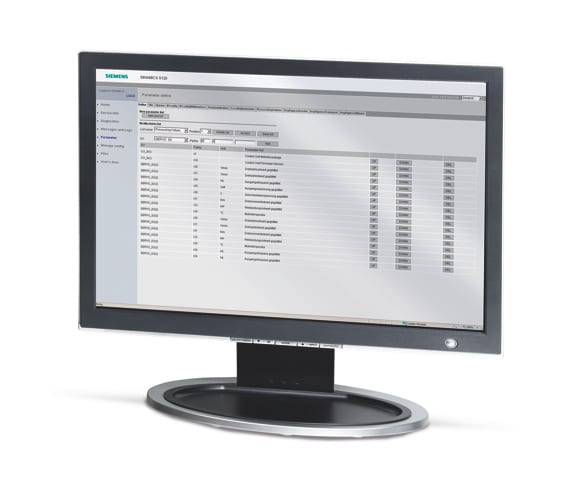
Sinamics integrated web server allows remote or local area maintenance checks at any time on various drive models in the Siemens drive family.
With this drive improvement, a user may access the Sinamics S120 with any PC with a browser capable of internet connectivity through a standard Ethernet interface to execute a variety of functions. If a wireless LAN (WLAN) router is networked, web pages can be viewed using other web-capable devices such as tablets and smart phones.
Among the functions possible with this integrated web server on Sinamics S120 drive systems are the ability to download a plant configuration, commission a drive from anywhere, perform firmware updates, access an immediate status overview on the drive, check and assess all alarm and fault messages. In addition, users can monitor and adapt all process or line parameter settings, archive machine documentation, including all notes taken, create customized server pages, set-up user administration and access level for operator and service personnel, plus perform virtually all drive diagnostics and remote maintenance actions. This combination of service possibilities results in significant reductions in machine or line downtimes due to faster, more efficient diagnostic and maintenance procedures.

Connectivity of the Siemens Sinamics drive system to the Internet for full web browsing, access and maintenance capability.
This Sinamics S120 drive system enhancement ideally suits applications where no special software or model version dependencies are desired. Series commissioning on a line is possible and the web server is compatible with all system security measures, such as a firewall. An up-to-date internet browser is sufficient for access. This web server capability is integral on Sinamics S120 drive firmware V4.6 or greater.
For more information about the Sinamics S120 web server, please visit: www.usa.siemens.com/sinamics-webserver-pr
—
Siemens Industry, Inc.
John Meyer
(847) 640-1595
john.meyer@siemens.com
Siemens Industry, Inc.
Hollie Davis
(770) 751-4882
hollie.davis@siemens.com
For specific product information and inquiries, call (800) 879-8079 ext. Marketing Communications or send an e-mail to: mc.us@siemens.com
Continue readingPLC, drive and motion-based functionality and architecture
Abstract
There are several architectural strategies that can be considered for web handling drive system controls. Current industrial control platforms permit the web handling controls to be implemented in either a Programmable Logic Controller (PLC) (typically the same as the machine control), directly in the drive system, or through a motion controller.
PLC-based web control has long been a traditional choice for machine builders for a number of reasons. The PLC provides a single platform for both automation and drive control with a centralized control structure. PLC-based systems offer a suitable level of usability, however, they can be limited in high-end performance capability and in their options for process-level programming.
Drive-based control typically offers distributed control architecture, peer-to-peer networks and an increased level of performance due to faster processing times. Graphical engineering tools are common for drive-based systems and are a preferred programming environment due to their ability to visualize and document the web control processes.
Motion controllers offer the highest level of performance and functional flexibility. Their inherent capability of providing position data can help increase web handling performance on several fronts. Motion controllers also permit the line integration of axis motion functionality such as positioning, electronic gearing and cam functionality in the common web controller. They are not limited by memory constraints and typically utilize the full range of programming languages.
This paper will review the merits of these three control architecture options in detail under the criteria of usability, functionality and performance, and also touch on the related topics of drive safety and remote diagnostics.
Overview / criteria
Usability
Usability defines the control system’s ease of use in the areas of engineering, commissioning, and maintenance. The following points apply to each of the control system options, PLC,
drive-based and motion control.
A common engineering tool utilizing a common database for machine and drive control is
recommended. Individual engineering tools for each controller (PLC, drives, etc.) should be
avoided. The engineering and programming connection to the system should be though a
single point with efficient routing to each drive or controller location in the system.
Additionally multi-user editing is an important feature for complex and large projects.
The programming language used for the web control should be considered for usability. The
programming language should be sufficient for implementing the critical tasks, easy-to-use
and understand. We find that the ideal programming language for the web control or drive
processes to be graphical function chart. Web handling control is a process and a graphical
programming editor offers the most efficient method to develop, visualize, support the
process and produce the system documentation.
The engineering platform should offer efficient and common diagnostic and troubleshooting
tools that include integrated online monitoring capability, time and frequency-based trace tools
and a drive axis commissioning control panel.
Control and drive hardware platforms that store programs on removable media are ideal.
The Compact Flash cards permit the easy swapping of hardware without the requirement
of program or parameter file downloading and retain current machine settings.
Download the brochure/PDF HERE.
—
For specific product information and inquiries, call (800) 879-8079 ext. Marketing Communications or send an e-mail to: SiemensMTBUMarCom.industry@siemens.com.
Siemens Industry Sector is the world’s leading supplier of innovative and environmentally friendly products, solutions and services for industrial customers. With end-to-end automation technology and industrial software, solid vertical-market expertise, and technology-based services, the sector enhances its customers’ productivity, efficiency and flexibility. With a global workforce of more than 100,000 employees, the Industry Sector comprises the Industry Automation, Drive Technologies and Customer Services Divisions as well as the Metals Technologies Business Unit. For more information, visit http://www.usa.siemens.com/industry.
The Siemens Drive Technologies Division is the world’s leading supplier of products, systems, applications, solutions and services for the entire drive train, with electrical and mechanical components. Drive Technologies serves all vertical markets in the production and process industries as well as the infrastructure/energy segment. With its products and solutions, the division enables its customers to achieve productivity, energy efficiency and reliability. For more information, visit http://www.usa.siemens.com/drivetechnologies.
Continue readingSee it at Pack Expo 2015! Siemens Booth: S-6137
Siemens has announced that its versatile Sinamics G120 drive system has been enhanced to include EtherNet/IP connectivity, thus providing maximum flexibility for industrial Ethernet communication while offering innovative concepts for those wanting a single network for the entire plant.
“In many instances, plant managers have the requirement for a single-plant network, particularly with large automotive, packaging, plastics, metals, food and beverage as well as material handling companies,” says Robert Soré, Siemens product manager, Sinamics G drives. “Our Sinamics G120 drive provides communications without limits to a specific network type.”
Sinamics G120 drives support, as standard, Profibus DP and Profinet to ensure seamless communications between every component involved in a typical automation solution including HMI (operator control and visualization) and I/O. Additional higher-level functions, including Safety Integrated telegrams and synchronized mechanisms for even the highest level control applications are also included.
Profinet can transmit operating and diagnostics data simultaneously to enterprise-level systems using standard IT mechanisms (TCP/IP) for an integrated factory environment. The new addition of an EtherNet/IP stack offers another option for Sinamics G120 users. Having the flexibility to communicate with the most common automation systems via Profinet or EtherNet/IP makes the Sinamics G120 drive system easily adaptable to the current Industrial Ethernet boom.
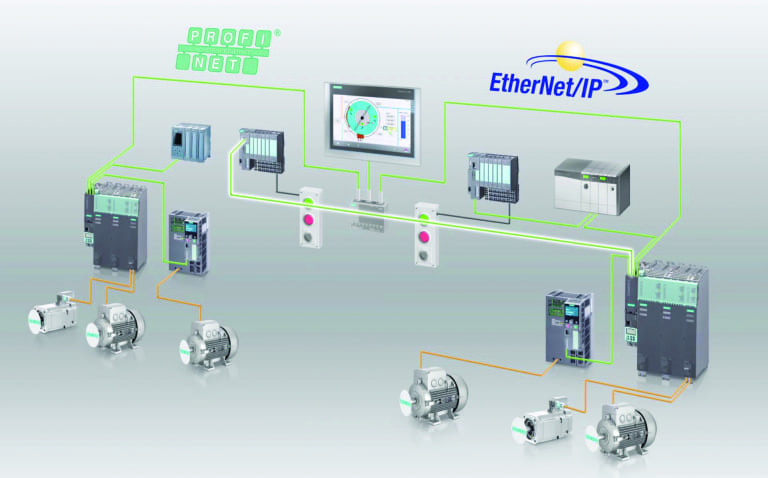
The Sinamics drive platform from Siemens provides users maximum flexibility
with industrial Ethernet connectivity.
With a wide power range (0.50 – 350 hp), highly scalable solutions, including safety integrated functionality and convenient start-up with Siemens Starter software, the Sinamics G120 drive is a powerful solution for a variety of applications, including packaging, plastics molding and extrusion, textile, printing and paper machines,
handling and assembly systems, rolling mills and test stands.
For more information about Siemens connectivity to EtherNet / IP platforms, visit www.usa.siemens.com/eip-drives.
For more information about the Sinamics G120 drive platform, visit www.usa.siemens.com/sinamics-g120.
—
For specific product information and inquiries, call (800) 879-8079 ext. Marketing Communications or send an e-mail to: SiemensMTBUMarCom.industry@siemens.com.
Continue readingSiemens announced today the release of its new single-axis Sinamics V20 AC drive, frame size E, with both Low Overload (LO) and High Overload (HO) ratings. The V20 family features easy setup and operation with excellent cost and energy efficiency. With a power rating ranging from 1/6–40hp at 480V AC, Sinamics V20 drives are available in five frame sizes and are ideal for material handling, conveyor, pump, fan and compressor applications.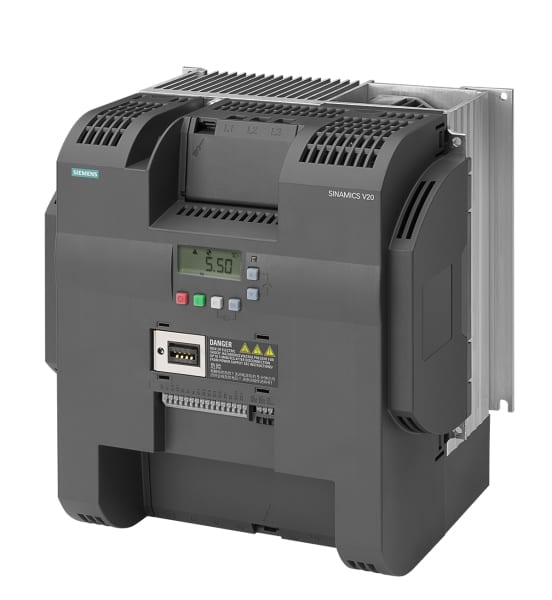
This compact drive can be connected and installed the conventional wall-mounting method or, optionally, mounted with heat sinks pushed through the enclosure wall. Since no additional modules or add-on options are required for operation, installation time is minimized.
The integrated Basic Operator Panel (BOP) enables trouble-free commissioning and operation on-site. Besides the universal serial interfaces that allow for easy connection to Simatic programmable logic controllers (PLCs), a Modbus interface is also included for communication with third-party controls. Pre-built connection and application macros are used for facilitating application-specific settings. For units with power ratings higher than 10hp, a braking resistor can be connected directly to the integrated braking chopper.
Operating the Sinamics V20 drive is just as easy as commissioning. Parameters that have been optimized for one application can easily be transferred to other drive units using SD cards via the Basic Operator Panel or the battery-operated Parameter Loader. The built-in display has the ability to list only those parameters changed from the factory default values rather than having to scroll through all of them.
Tailored inter-connectivity and application macros (i.e. for pumps, fans and compressors) provide the correct settings for the particular application. The Keep Running Mode automatically adapts the V20 drive to the power supply to achieve higher availability when operated on unstable networks. In this mode, line fluctuations are compensated for internally and error messages are acknowledged autonomously. Thanks to enhanced cooling and coated PCBs and electronic components, the Sinamics V20 is extremely rugged, making the unit reliable even in harsh environments.
The demand-driven regulation of the motor speed also provides increased energy savings even for many applications. The Sinamics V20 is equipped with an energy-optimized control mode (ECO-mode) for increased energy efficiency. ECO-mode automatically adapts the magnetic flux in the motor to the optimum operating point. The DC link coupling enables efficient energy utilization of drives grouped together. The Sinamics V20 can also be set to hibernation mode, which prolongs the service life of the motor and also reduces system component wear (i.e. pumps). Additionally, by displaying real-time energy consumption on the operator panel display, the operator always has the drive’s energy and cost efficiencies in focus at all times.
For more information about the Sinamics V20 drive, please visit:
www.usa.siemens.com/sinamics-v20-pr
—
For specific product information and inquiries, call (800) 879-8079
ext. Marketing Communications or send an e-mail to: SiemensMTBUMarCom.industry@siemens.com
Co-rotating twin-screw compound extruder used in R&D facility to test material batches, recipes; pre-configured extrusion solution on control package monitors entire machine, providing “big data” for customer at attractive price point
KRAIBURG TPE Corporation in Duluth, Ga. is a manufacturer of custom-made thermoplastic elastomer (TPE) compounds for a variety of market applications in the automotive, medical, general industrial and myriad consumer sectors. At the Duluth facility, the product development department routinely evaluates material batches and new custom compounds for performance and customer specification viability. As an integral step in that process, KRAIBURG TPE engineers utilize sophisticated co-rotating, twin-screw extruder technology provided by KraussMaffei Berstorff, from its facility in Florence, Ky.
Owing to the substantial varieties of color, durometer and the wide-ranging performance properties required at KRAIBURG TPE, monitoring every aspect of the machine performance is critical. This includes all temperatures, speeds, pressures and torque on the extruder itself, plus an underwater pelletizer, gear pump and multiple loss-of-weight feeders used on the line.
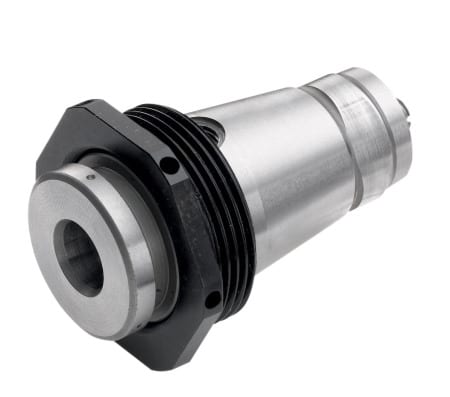
At a glance, the operator sees the condition of the machine in real time and can make better on-the-fly adjustments
For the latest machine installed at the KRAIBURG TPE facility, as senior application engineer at KraussMaffei Bertstorff, David Frankenberg, explains, “The lab extrusion line is used for both process and product development assessment. A key requirement was the generation of all data in real time, as part of the management system to be used, as well as the condition monitoring system needed for predictive maintenance strategies being employed.” In cooperation with the KRAIBURG TPE team and after evaluating the competitors for the control scheme, KraussMaffei turned to Siemens for assistance, as this supplier was able to bring a pre-configured and highly cost-effective solution to the requirements on this machine.
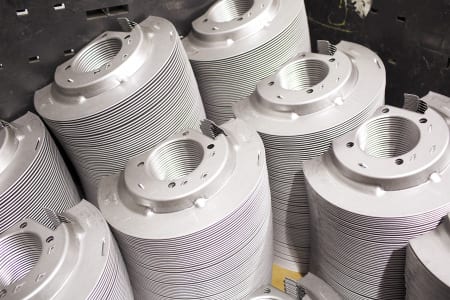
Siemens temp zone control system monitors all aspects of extruder, providing “big data” to the host network
As Frankenberg and his electrical engineering associate Martin Gonzalez detailed, the Siemens EXT3370 application package represented a blending of the current PLC technology and drives platform with an HMI capable of providing all graphics and multiple data screens on a single display. In addition, the system had the ability to feed the “big data” directly to the KRAIBURG TPE process data archival & analysis system, where it would reside for real-time and long-range performance evaluation by the product development, quality and process teams. All speeds, pressures, temperatures and other parameters can be instantly assessed, using set point and actual value data on the display, either at the machine HMI or a remote monitor within the KRAIBURG TPE network.
On the KraussMaffei Bertstorff machine, the control system comprises the software solution, Siemens drives and motors, the ability to monitor up to 32 separate temperature zones, touch screen technology on a 15” HMI and scalability on the drives to accept the ancillary equipment being monitored at the KRAIBURG TPE facility. In this way, a truly customized solution was devised using an entirely standard and thus highly cost-effective array of components, according to Frankenberg. As an additional benefit, he noted, the training needed was minimal, owing to the plain language on the control with no need for knowledge of high-level programming skills. Finally, all compound recipes can be easily transferred via USB for portability and security.
Allen Donn, product development engineer at KRAIBURG TPE, along with his team of engineers and tech specialists, evaluated the installation and commissioning of the machine at the Duluth facility. “The data transfer from the PLC into the same process data archival & analysis system that we use for our other lines at KRAIBURG TPE. A simple Excel file is generated with any parameters desired for analysis, plus we can easily exchange data between R&D and production here. The result is that our ability to utilize production machinery more efficiently has increased substantially with the use of the new KraussMaffei Bertstorff machine in our test department, as the control system gives us real-time hard data we can use to make adjustments on new recipes and entirely new materials.” KRAIBURG TPE performs extensive new compound property performance testing on its TPE formulae and the time compression realized by using the new extruder line in this “real world” R&D operation is providing substantial advantages for the compounder.

Various compounds are formulated at Kraiburg and test run on the KraussMaffei Berstorff extruder at the Kraiburg lab in Duluth, Georgia
KRAIBURG TPE typically runs materials in the 20-80 Shore A hardness range and, as an example, might test out a variety of adhesion grades for over-molding onto polycarbonate, nylon, or other substrates, Donn explained. “When we can pull the data from any machine in the system, adjust it, run it on the R&D machine, and then feed that data back into production, it makes a huge difference in our efficiencies.” In one instance, shortly after the KraussMaffei machine was installed, KRAIBURG TPE engineers were testing 15 compound varieties on the machine very quickly, compared to using production equipment to do that task. “I could look into the software to compare all set point and actual values, remotely, over the entire test period,” Donn noted. He added that the substantial raw material cost savings of more tests, faster results and less waste all contribute to an improved profitability for the company, as well.
For more information on this story, please contact:
KRAIBURG TPE CORPORATION
2625 North Berkeley Lake Road
Duluth, GA 30096
Phone: 678-584-5020
www.KRAIBURG-tpe.com
info-america@KRAIBURG-tpe.com
Attention: Katherine Olano
Or
KRAUSSMAFFEI GROUP USA
7095 Industrial Road
Florence, KY 41042
Phone : 859-283-0200
www.kraussmaffei.com
david.frankenberg@kraussmaffei.com
Attention : David Frankenberg
Or
SIEMENS
Digital Factory
5300 Triangle Parkway
Norcross, GA 30092
Phone : 770-871-3848
www.usa.siemens.com/plastics
mathias.radziwill@siemens.com
Attention : Mathias Radziwill